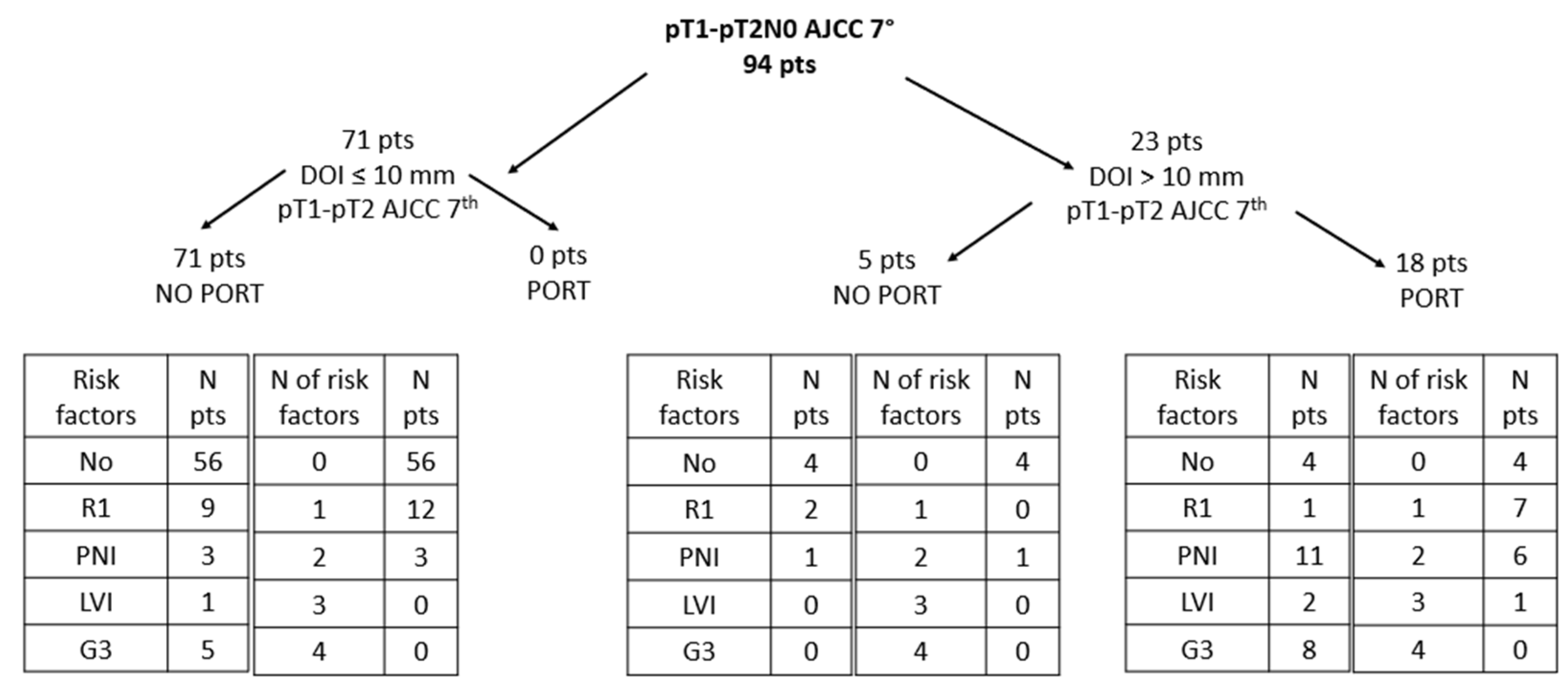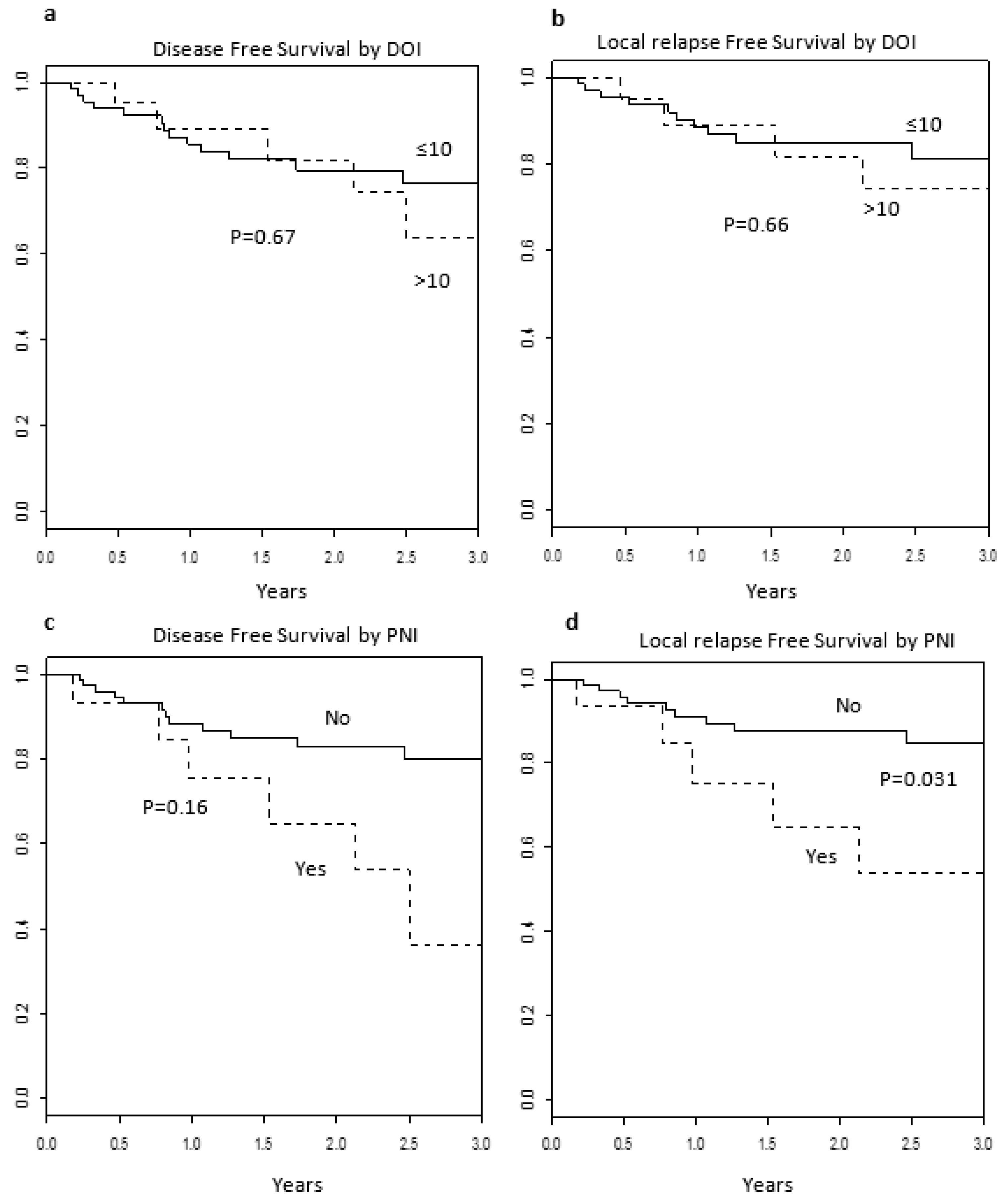The Impact of Post-Operative Radiotherapy in Early Stage (pT1-pT2N0M0) Oral Tongue Squamous Cell Carcinoma in Era of DOI
Abstract
:Simple Summary
Abstract
1. Introduction
2. Materials and Methods
2.1. Treatment Strategy and Follow Up
2.2. Statistical Analysis
3. Results
3.1. Postoperative Radiotherapy (PORT)
3.2. Stage Migration
3.3. Tumor-Related Risk Factors
3.4. Association between DOI and Other Tumor-Related Risk Factors
3.5. Clinical Outcomes
3.6. Multivariable Analysis
4. Discussion
5. Conclusions
Author Contributions
Funding
Institutional Review Board Statement
Informed Consent Statement
Data Availability Statement
Acknowledgments
Conflicts of Interest
References
- National Comprehensive Cancer Network (NCCN). Guidelines Version 1. 2021. Available online: https://www.nccn.org/store/login/login.aspx?ReturnURL=https://www.nccn.org/professionals/physician_gls/pdf/head-and-neck.pdf (accessed on 1 November 2020).
- Amin, M.B.; Edge, S.; Greene, F.; David, R.; Byrd, D.R.; Brookland, R.K.; Washington, M.K.; Gershenwald, J.E.; Compton, C.C.; Hess, K.R.; et al. AJCC Cancer Staging Manual, 8th ed.; Springer: Berlin/Heidelberg, Germany, 2017; Available online: https://www.springer.com/gp/book/9783319406176 (accessed on 15 June 2021).
- Ebrahimi, A.; Gil, Z.; Amit, M.; Yen, T.; Liao, C.; Chaturvedi, P.; Agarwal, J.P.; Kowalski, L.P.; Köhler, H.F.; Kreppel, M.; et al. International Consortium for Outcome Research (ICOR) in Head and Neck Cancer. Depth of invasion alone as an indication for postoperative radiotherapy in small oral squamous cell carcinomas: An International Collaborative Study. Head Neck 2019, 41, 1935–1942. [Google Scholar] [CrossRef]
- Ivaldi, E.; Di Mario, D.; Paderno, A.; Piazza, C.; Bossi, P.; Iacovelli, N.A.; Incandela, F.; Locato, L.; Fallai, C.; Orlandi, E. Postoperative radiotherapy (PORT) for early oral cavity cancer (pT 1-2, N0-1): A review. Crit. Rev. Oncol. Hematol. 2019, 143, 67–75. [Google Scholar] [CrossRef]
- Lee, N.C.J.; Eskander, A.; Park, H.S.; Mehra, S.; Burtness, B.A.; Husain, Z. Pathologic staging changes in oral cavity squamous cell carcinoma: Stage migration and implications for adjuvant treatment. Cancer 2019, 125, 2975–2983. [Google Scholar] [CrossRef] [PubMed]
- Kukreja, P.; Parekh, D.; Roy, P. Practical Challenges in Measurement of Depth of Invasion in Oral Squamous Cell Carcinoma: Pictographical Documentation to Improve Consistency of Reporting per the AJCC 8th Edition Recommendations. Head Neck Pathol. 2020, 14, 419–427. [Google Scholar] [CrossRef] [PubMed]
- Yuen, A.P.; Ng, R.W.; Lam, P.K.; Ho, A. Preoperative measurement of tumor thickness of oral tongue carcinoma with intraoral ultrasonography. Head Neck 2008, 30, 230–234. [Google Scholar] [CrossRef] [PubMed]
- Howaldt, H.P.; Kainz, M.; Euler, B.; Vorast, H. Proposal for modification of the TNM staging classification for cancer of the oral cavity. Craniomaxillofac. Surg. 1999, 27, 275–288. [Google Scholar] [CrossRef] [PubMed]
- Al-Rajhi, N.; Khafaga, Y.; El-Husseiny, J.; Saleem, M.; Mourad, W.; Al-Otieschan, A.; Al-Amro, A. Early stage carcinoma of oral tongue: Prognostic factors for local control and survival. Oral. Oncol. 2000, 36, 508–514. [Google Scholar] [CrossRef]
- Mishra, R.C.; Parida, G.; Mishra, T.K.; Mohanty, S. Tumour thickness and relationship to locoregional failure in cancer of the buccal mucosa. Eur. J. Surg. Oncol. 1999, 25, 186–189. [Google Scholar] [CrossRef]
- Gonzalez-Moles, M.A.; Esteban, F.; Rodriguez-Archilla, A.; Ruiz-Avila, I.; Gonzalez-Moles, S. Importance of tumour thickness measurement in prognosis of tongue cancer. Oral. Oncol. 2002, 38, 394–397. [Google Scholar] [CrossRef]
- Urist, M.M.; O’Brien, C.J.; Soong, S.J.; Visscher, D.W.; Maddox, W.A. Squamous cell carcinoma of the buccal mucosa: Analysis of prognostic factors. Am. J. Surg. 1987, 154, 411–414. [Google Scholar] [CrossRef]
- Clark, J.R.; Naranjo, N.; Franklin, J.H.; de Almeida, J.; Gullane, P.J. Established prognostic variables in N0 oral carcinoma. Otolaryngol. Head Neck Surg. 2006, 135, 748–753. [Google Scholar] [CrossRef] [PubMed]
- Caldeira, P.C.; López Soto, A.M.; Ferreira de Aguiar, M.C.; Castro Martins, C. Tumor depth of invasion and prognosis of early-stage oral squamous cell carcinoma: A meta-analysis. Oral. Dis. 2020, 26, 1357–1365. [Google Scholar] [CrossRef] [PubMed]
- Liao, C.T.; Lin, C.Y.; Fan, K.H. Identification of a high-risk group among patients with oral cavity squamous cell carcinoma and pT1-2N0 disease. Int. J. Radiat. Oncol. Biol. Phys. 2012, 82, 284–290. [Google Scholar] [CrossRef] [PubMed]
- Brennan, S.; Corry, J.; Kleid, S.; Porceddu, S.; Yuen, K.; Rischin, D.; Peters, L.J. Clinical Trial Prospective trial to evaluate staged neck dissection or elective neck radiotherapy in patients with CT-staged T1-2 N0 squamous cell carcinoma of the oral tongue. Head Neck 2010, 32, 191–198. [Google Scholar] [PubMed]
- Cramer, J.D.; Samant, S.; Heron, D.E.; Ferris, R.L.; Kim, S. Impact of postoperative radiation therapy for deeply invasive oral cavity cancer upstaged to stage III. Head Neck 2019, 41, 1178–1183. [Google Scholar] [CrossRef] [PubMed]
- Li, Y.; Bai, S.; Carroll, W.; Dayan, D.; Dort, J.C.; Heller, K.; Jour, G.; Lau, H.; Penner, C.; Prystowsky, M.; et al. Validation of the risk model: High-risk classification and tumor pattern of invasion predict outcome for patients with low-stage oral cavity squamous cell carcinoma. Head Neck Pathol. 2013, 7, 211–223. [Google Scholar] [CrossRef] [PubMed] [Green Version]
- Cracchiolo, J.R.; Xu, B.; Migliacci, J.C.; Katabi, N.; Pfister, D.G.; Lee, N.Y.; Patel, S.G.; Ghossein, R.A.; Wong, R.J. Patterns of recurrence in oral tongue cancer with perineural invasion. Head Neck 2018, 40, 1287–1295. [Google Scholar] [CrossRef]
- Bjerkli, I.H.; Laurvik, H.; Nginamau, E.S.; Søland, T.M.; Costea, D.; Hov, H.; Uhlin-Hansen, L.; Hadler-Olsen, E.; Steigen, S.E. Tumor budding score predicts lymph node status in oral tongue squamous cell carcinoma and should be included in the pathology report. PLoS ONE 2020, 15, e0239783. [Google Scholar] [CrossRef]


| Characteristics | Number of Patients n = 94 (100%) | |
|---|---|---|
| Age | Median, quartile | 63, 73–43 |
| Gender, n (%) | Female | 46 (49) |
| Male | 48 (51) | |
| Tobacco smoking status, n (%) | Yes | 20 (21%) |
| No | 42 (45%) | |
| Former | 32 (34%) | |
| Alcohol consumption, n (%) | Yes | 21 (22%) |
| No | 72 (77%) | |
| Former | 1 (1%) | |
| TNM classification (AJCC 7th), n (%) | pT1N0M0 | 59(63%) |
| pT2N0M0 | 35 (37%) | |
| TNM classification (AJCC 8th), n (%) | pT1N0M0 (Stage I) | 42 (45%) |
| pT2N0M0 (Stage II) | 29 (31%) | |
| pT3N0 | 23 (24%) | |
| Neck Dissection, n (%) | Yes | 43 (46%) |
| No | 51 (54%) | |
| Adjuvant treatment, n (%) | No | 76 (81%) |
| PORT | 17 (18%) | |
| PORT + Chemother | 1 (1%) | |
| Heading | AJCC 8th Ed | ||||
|---|---|---|---|---|---|
| AJCC 7th Ed | T1 (100%) | T2 (100%) | T3 (100%) | Total | |
| T1 | 41 (98%) | 11 (38%) | 7 (30%) | 59 (63%) | |
| T2 | 1 (2%) | 18 (62%) | 16 (70%) | 35 (37%) | |
| Total | 42 (45%) | 29 (31%) | 23 (24%) | 94 (100%) | |
| Characteristics | Total (n = 94 (%)) | ND (n = 42) | No ND (n = 52) | |
|---|---|---|---|---|
| Risk Factor | R1 | 11 (12%) | 3 | 8 |
| R0 | 83 (88%) | 39 | 44 | |
| PNI | 15 (16%) | 11 | 4 | |
| No PNI | 79 (84%) | 31 | 48 | |
| LVI | 3 (3%) | 3 | 0 | |
| No LVI | 91 (97%) | 39 | 52 | |
| G3 | 13 (14%) | 8 | 5 | |
| G1–G2 | 73 (78%) | 33 | 40 | |
| Unknown | 8 (8%) | 1 | 7 | |
| No. of Risk Factors | 0 | 64 (68%) | 26 | 38 |
| 1 | 19 (20%) | 8 | 11 | |
| 2 | 10 (11%) | 7 | 3 | |
| 3 | 1 (1%) | 1 | 0 | |
| All | Events | HR | Low 95%CI | Up 95%CI | p-Value | |||
|---|---|---|---|---|---|---|---|---|
| DFS | DOI | Continuum | 94 | 25 | 1.11 | 0.99 | 1.24 | 0.06 |
| PORT | No | 76 | 21 | 1 | ||||
| Yes | 18 | 4 | 0.20 | 0.05 | 0.92 | 0.04 | ||
| PNI | No | 79 | 19 | 1 | ||||
| Yes | 15 | 6 | 2.38 | 0.83 | 6.82 | 0.11 | ||
| RFS | DOI | Continuum | 94 | 19 | 1.08 | 0.94 | 1.23 | 0.26 |
| PORT | No | 76 | 16 | 1 | ||||
| Yes | 18 | 3 | 0.19 | 0.04 | 1.09 | 0.06 | ||
| PNI | No | 79 | 13 | 1 | ||||
| Yes | 15 | 6 | 3.98 | 1.28 | 12.40 | 0.02 | ||
| Local RFS | DOI | Continuum | 94 | 15 | 1.06 | 0.91 | 1.24 | 0.45 |
| PORT | No | 76 | 12 | 1 | ||||
| Yes | 18 | 3 | 0.30 | 0.05 | 1.98 | 0.21 | ||
| PNI | No | 79 | 10 | 1 | ||||
| Yes | 15 | 5 | 4.03 | 1.09 | 14.8 | 0.04 | ||
| OS | DOI | Continuum | 94 | 9 | 1.07 | 0.90 | 1.28 | 0.45 |
| PORT | No | 76 | 8 | 1 | ||||
| Yes | 18 | 1 | 0.33 | 0.025 | 5.28 | 0.43 |
Publisher’s Note: MDPI stays neutral with regard to jurisdictional claims in published maps and institutional affiliations. |
© 2021 by the authors. Licensee MDPI, Basel, Switzerland. This article is an open access article distributed under the terms and conditions of the Creative Commons Attribution (CC BY) license (https://creativecommons.org/licenses/by/4.0/).
Share and Cite
Alterio, D.; D’Urso, P.; Volpe, S.; Tagliabue, M.; De Berardinis, R.; Augugliaro, M.; Gandini, S.; Maffini, F.A.; Bruschini, R.; Turturici, I.; et al. The Impact of Post-Operative Radiotherapy in Early Stage (pT1-pT2N0M0) Oral Tongue Squamous Cell Carcinoma in Era of DOI. Cancers 2021, 13, 4851. https://doi.org/10.3390/cancers13194851
Alterio D, D’Urso P, Volpe S, Tagliabue M, De Berardinis R, Augugliaro M, Gandini S, Maffini FA, Bruschini R, Turturici I, et al. The Impact of Post-Operative Radiotherapy in Early Stage (pT1-pT2N0M0) Oral Tongue Squamous Cell Carcinoma in Era of DOI. Cancers. 2021; 13(19):4851. https://doi.org/10.3390/cancers13194851
Chicago/Turabian StyleAlterio, Daniela, Pasqualina D’Urso, Stefania Volpe, Marta Tagliabue, Rita De Berardinis, Matteo Augugliaro, Sara Gandini, Fausto Antonio Maffini, Roberto Bruschini, Irene Turturici, and et al. 2021. "The Impact of Post-Operative Radiotherapy in Early Stage (pT1-pT2N0M0) Oral Tongue Squamous Cell Carcinoma in Era of DOI" Cancers 13, no. 19: 4851. https://doi.org/10.3390/cancers13194851
APA StyleAlterio, D., D’Urso, P., Volpe, S., Tagliabue, M., De Berardinis, R., Augugliaro, M., Gandini, S., Maffini, F. A., Bruschini, R., Turturici, I., Riccio, S., Calabrese, L., Farneti, A., Starzyńska, A., Ferrari, A., Jereczek-Fossa, B. A., Ansarin, M., & Sanguineti, G. (2021). The Impact of Post-Operative Radiotherapy in Early Stage (pT1-pT2N0M0) Oral Tongue Squamous Cell Carcinoma in Era of DOI. Cancers, 13(19), 4851. https://doi.org/10.3390/cancers13194851









